Презентация slides lectures 19






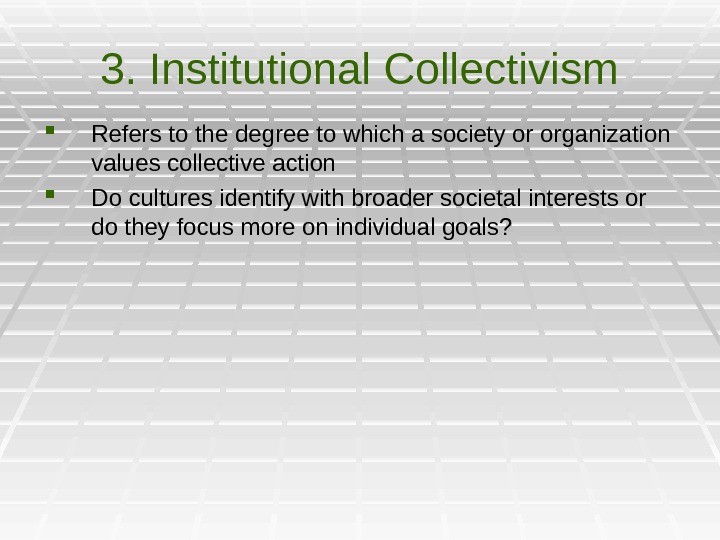

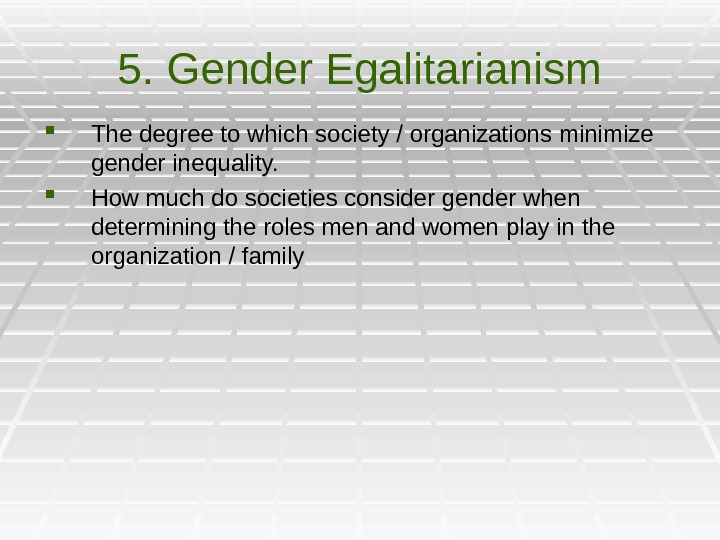

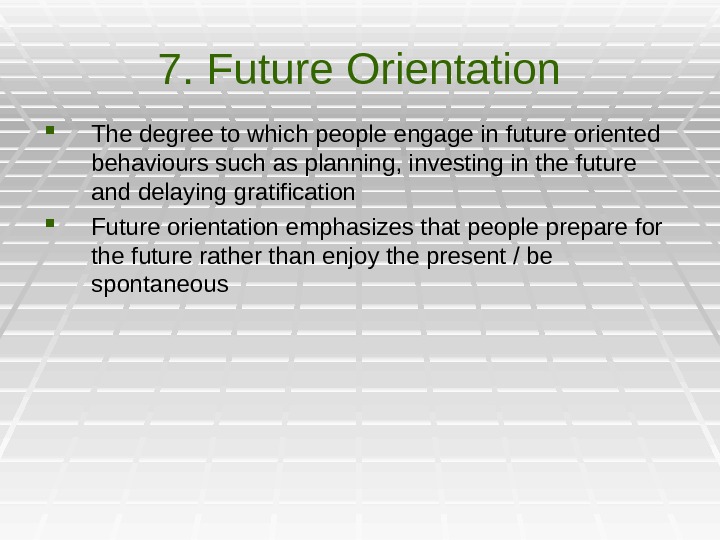




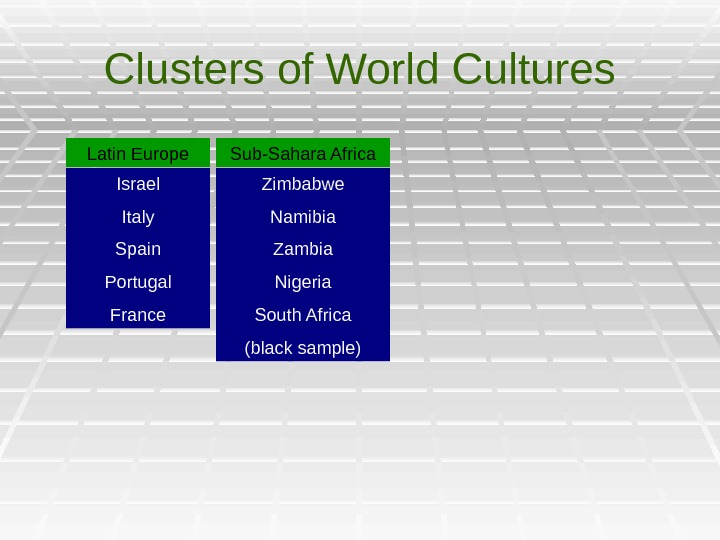
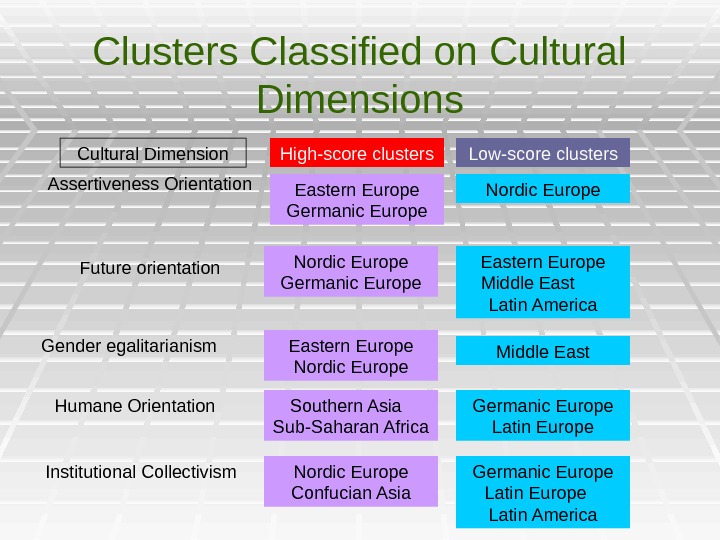

- Размер: 322 Кб
- Количество слайдов: 18
Описание презентации Презентация slides lectures 19 по слайдам
 Leadership & Motivation MGT 3206 Lecture 19 National Cultures, Globalization & Leadership
Leadership & Motivation MGT 3206 Lecture 19 National Cultures, Globalization & Leadership
 Dimensions of Culture How do cultures differ? Hofstede (2001) analyzed questionnaires from 100, 000 people in 50 countries and identified 5 major dimensions of culture that show they differ: 1. Power distance 2. Uncertainty avoidance 3. Individualism – Collectivism 4. Masculinity – Femininity 5. Long-term – Short-term orientation
Dimensions of Culture How do cultures differ? Hofstede (2001) analyzed questionnaires from 100, 000 people in 50 countries and identified 5 major dimensions of culture that show they differ: 1. Power distance 2. Uncertainty avoidance 3. Individualism – Collectivism 4. Masculinity – Femininity 5. Long-term – Short-term orientation
 Dimensions of Culture Building and expanding on Hofstede (2001) was the very influential GLOBE studies by House et. al (2004) They published the 800 page Culture, Leadership & Organizations: The GLOBE Study of 62 Societies. It is an ongoing research project of more than 160 separate investigations The goal of GLOBE is to increase our understanding of cross cultural interactions and the impact of culture on leadership effectiveness More than 17, 000 managers in 950 organizations have participated to date
Dimensions of Culture Building and expanding on Hofstede (2001) was the very influential GLOBE studies by House et. al (2004) They published the 800 page Culture, Leadership & Organizations: The GLOBE Study of 62 Societies. It is an ongoing research project of more than 160 separate investigations The goal of GLOBE is to increase our understanding of cross cultural interactions and the impact of culture on leadership effectiveness More than 17, 000 managers in 950 organizations have participated to date
 Dimensions of Culture Some of the GLOBE findings correlate with Hofstede’s research findings. Togethere are 9 cultural dimensions that distinguish different cultural groups. We will look at these now:
Dimensions of Culture Some of the GLOBE findings correlate with Hofstede’s research findings. Togethere are 9 cultural dimensions that distinguish different cultural groups. We will look at these now:
 1. Uncertainty Avoidance Refers to the extent to which society or organizations rely on established social norms and procedures to avoid uncertainty Uncertainty avoidance is concerned with how cultures use rules and laws to make things more predictable and less uncertain
1. Uncertainty Avoidance Refers to the extent to which society or organizations rely on established social norms and procedures to avoid uncertainty Uncertainty avoidance is concerned with how cultures use rules and laws to make things more predictable and less uncertain
 2. Power Distance This refers to the degree to which members of a group expect and agree power should be shared unequally. Power distance is about how egalitarian society is based on the number of hierarchical levels that separate people based on class, wealth, possessions, authority etc
2. Power Distance This refers to the degree to which members of a group expect and agree power should be shared unequally. Power distance is about how egalitarian society is based on the number of hierarchical levels that separate people based on class, wealth, possessions, authority etc
 3. Institutional Collectivism Refers to the degree to which a society or organization values collective action Do cultures identify with broader societal interests or do they focus more on individual goals?
3. Institutional Collectivism Refers to the degree to which a society or organization values collective action Do cultures identify with broader societal interests or do they focus more on individual goals?
 4. In-Group Collectivism Refers to the degree to which people express pride, loyalty and cohesiveness in their organizations / families. In-group collectivism is concerned with how far people are devoted to family / organization
4. In-Group Collectivism Refers to the degree to which people express pride, loyalty and cohesiveness in their organizations / families. In-group collectivism is concerned with how far people are devoted to family / organization
 5. Gender Egalitarianism The degree to which society / organizations minimize gender inequality. How much do societies consider gender when determining the roles men and women play in the organization / family
5. Gender Egalitarianism The degree to which society / organizations minimize gender inequality. How much do societies consider gender when determining the roles men and women play in the organization / family
 6. Assertiveness The degree to which people in a culture are determined, assertive, confrontational and aggressive in their social relationships Assertiveness is concerned with how much a culture or society encourages people to be assertive and tough with others as opposed to being timid and submissive
6. Assertiveness The degree to which people in a culture are determined, assertive, confrontational and aggressive in their social relationships Assertiveness is concerned with how much a culture or society encourages people to be assertive and tough with others as opposed to being timid and submissive
 7. Future Orientation The degree to which people engage in future oriented behaviours such as planning, investing in the future and delaying gratification Future orientation emphasizes that people prepare for the future rather than enjoy the present / be spontaneous
7. Future Orientation The degree to which people engage in future oriented behaviours such as planning, investing in the future and delaying gratification Future orientation emphasizes that people prepare for the future rather than enjoy the present / be spontaneous
 8. Performance Orientation The extent to which a society or organization encourages and rewards people for improved performance and excellence Are people in the culture rewarded for setting and meeting challenging goals?
8. Performance Orientation The extent to which a society or organization encourages and rewards people for improved performance and excellence Are people in the culture rewarded for setting and meeting challenging goals?
 9. Humane Orientation The degree to which a society or organization encourages and rewards people for being fair, altruistic, generous and caring to others How much does the society emphasize sensitivity to others, social support and community values?
9. Humane Orientation The degree to which a society or organization encourages and rewards people for being fair, altruistic, generous and caring to others How much does the society emphasize sensitivity to others, social support and community values?
 Clusters of World Cultures Eastern Europe Greece Hungary Albania Slovenia Poland Russia Georgia Kazakhstan Middle East Turkey Kuwait Egypt Morocco Qatar Confucian Asia Southern Asia Philippines Indonesia Malaysia India Thailand Iran. Singapore Hong Kong Taiwan China South Korea Japan
Clusters of World Cultures Eastern Europe Greece Hungary Albania Slovenia Poland Russia Georgia Kazakhstan Middle East Turkey Kuwait Egypt Morocco Qatar Confucian Asia Southern Asia Philippines Indonesia Malaysia India Thailand Iran. Singapore Hong Kong Taiwan China South Korea Japan
 Clusters of World Cultures Eastern Europe ELatin America Ecuador El Salvador Colombia Bolivia Brazil Guatemala Argentina Costa Rica Venezuela Mexico Nordic Europe Denmark Finland Sweden Anglo Germanic Europe Austria Netherlands Switzerland Germany. Canada USA Australia Ireland England South Africa (whites) New Zealand
Clusters of World Cultures Eastern Europe ELatin America Ecuador El Salvador Colombia Bolivia Brazil Guatemala Argentina Costa Rica Venezuela Mexico Nordic Europe Denmark Finland Sweden Anglo Germanic Europe Austria Netherlands Switzerland Germany. Canada USA Australia Ireland England South Africa (whites) New Zealand
 Clusters of World Cultures Eastern Europe ELatin Europe Israel Italy Spain Portugal France Sub-Sahara Africa Zimbabwe Namibia Zambia Nigeria South Africa (black sample)
Clusters of World Cultures Eastern Europe ELatin Europe Israel Italy Spain Portugal France Sub-Sahara Africa Zimbabwe Namibia Zambia Nigeria South Africa (black sample)
 Clusters Classified on Cultural Dimensions Cultural Dimension Assertiveness Orientation High-score clusters Eastern Europe Germanic Europe Low-score clusters Nordic Europe Future orientation Nordic Europe Germanic Europe Eastern Europe Middle East Latin America Gender egalitarianism Eastern Europe Nordic Europe Middle East Humane Orientation Southern Asia Sub-Saharan Africa Germanic Europe Latin Europe Institutional Collectivism Nordic Europe Confucian Asia Germanic Europe Latin America
Clusters Classified on Cultural Dimensions Cultural Dimension Assertiveness Orientation High-score clusters Eastern Europe Germanic Europe Low-score clusters Nordic Europe Future orientation Nordic Europe Germanic Europe Eastern Europe Middle East Latin America Gender egalitarianism Eastern Europe Nordic Europe Middle East Humane Orientation Southern Asia Sub-Saharan Africa Germanic Europe Latin Europe Institutional Collectivism Nordic Europe Confucian Asia Germanic Europe Latin America
 Clusters Classified on Cultural Dimensions Cultural Dimension In-group collectivism High-score clusters Confucian Asia Eastern Europe Latin America Middle East Southern Asia Low-score clusters Nordic Europe Germanic Europe Anglo Performance orientation Anglo Confucian Asia Germanic Europe Eastern Europe Latin America Uncertainty Avoidance Germanic Europe Nordic Europe Eastern Europe Latin America Middle East
Clusters Classified on Cultural Dimensions Cultural Dimension In-group collectivism High-score clusters Confucian Asia Eastern Europe Latin America Middle East Southern Asia Low-score clusters Nordic Europe Germanic Europe Anglo Performance orientation Anglo Confucian Asia Germanic Europe Eastern Europe Latin America Uncertainty Avoidance Germanic Europe Nordic Europe Eastern Europe Latin America Middle East
